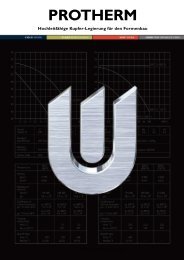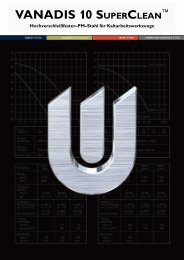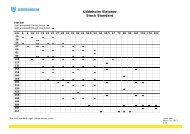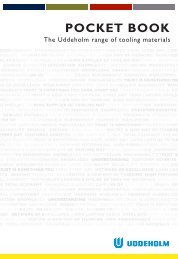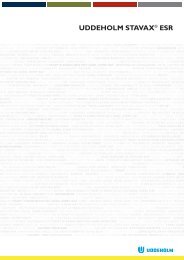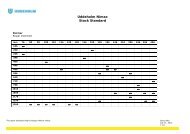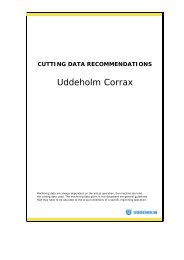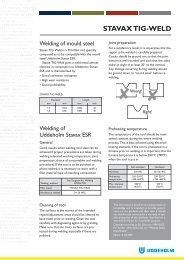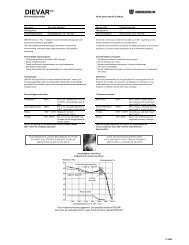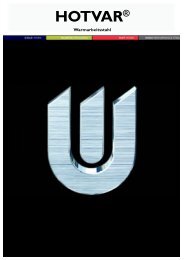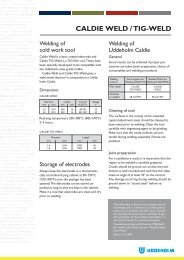download - Uddeholm
download - Uddeholm
download - Uddeholm
You also want an ePaper? Increase the reach of your titles
YUMPU automatically turns print PDFs into web optimized ePapers that Google loves.
CALMAX/CARMO WELD/TIG-WELD<br />
Welding of plastic mould<br />
steel and cold work steel<br />
Calmax/Carmo Weld is a basic coated electrode<br />
and Calmax/Carmo TIG-Weld is a TIG<br />
filler rod. These are suitable for welding of the<br />
tool steels <strong>Uddeholm</strong> Calmax and <strong>Uddeholm</strong><br />
Carmo.<br />
Calmax/Carmo Weld and Calmax/Carmo<br />
TIG-Weld gives a weld metal identical in<br />
composition to <strong>Uddeholm</strong> Calmax and <strong>Uddeholm</strong><br />
Carmo and are characterized by:<br />
•Good toughness<br />
•Good wear resistance<br />
•Good flame and induction hardenability<br />
•Good polishability<br />
•Good photo-etchability.<br />
For polishing and photo-etching Calmax/Carmo<br />
TIG-Weld is recommended.<br />
Dimensions<br />
CALMAX/CARMO WELD<br />
Diameter Length Current Voltage<br />
mm inch mm inch A (DC+) V<br />
2,5 0,10 350 14 65–110 ~23<br />
3,25 0,12 350 14 80–165 ~23<br />
Redrying temperature 250–300°C (480–570°F)<br />
2–3 hours.<br />
CALMAX/CARMO TIG-WELD<br />
Diameter<br />
Length<br />
mm inch mm inch<br />
1,6 0,06 1000 40<br />
Storage of electrodes<br />
Always keep the electrodes in a thermostatically<br />
controlled drying cabinet at 50–150°C<br />
(120–300°F) once the package has been<br />
opened. The electrodes can be stored unpacked<br />
as long as they are kept in the cabinet.<br />
Make it a rule that electrodes are clean and dry<br />
prior to welding.<br />
Welding of the<br />
<strong>Uddeholm</strong> tool steels<br />
Calmax and Carmo<br />
General<br />
Good results when welding tool steel can be<br />
achieved if proper precautions are taken during<br />
welding (elevated working temperature, joint<br />
preparation, choice of consumables and welding<br />
procedure). If the tool is to be polished or<br />
photo-etched, it is necessary to use a filler<br />
material that has the same chemical composition<br />
as the base material.<br />
Welding Gas Tungsten Arc Shielded Metal Arc<br />
method Welding GTAW/TIG Welding SMAW/MMA<br />
Filler metal CALMAX/CARMO CALMAX/CARMO<br />
TIG-WELD<br />
WELD<br />
Hardness<br />
as welded 58–61 HRC 58–61 HRC<br />
Cleaning of tool<br />
Clean the tool carefully with degreasing agent<br />
or by grinding before welding. The surfaces in<br />
the vicinity of the intended repairs/adjustment<br />
should be cleaned to base metal prior to doing<br />
anything. Make sure that the cavity surfaces are<br />
protected during welding, especially if these are<br />
polished.<br />
Joint preparation<br />
For a satisfactory result, it is imperative that the<br />
region to be welded is carefully prepared.<br />
Cracks should be ground out so that the joint<br />
bottom is well rounded and such that the sides<br />
make an angle of at least 30° to the vertical.<br />
This information is based on our present state of<br />
knowledge and is intended to provide general<br />
notes on our products and their uses. It should<br />
not therefore be construed as a warranty of specific<br />
properties of the products described or a<br />
warranty for fitness for a particular purpose.<br />
Classified according to EU Directive 1999/45/EC<br />
For further information see our “Material Safety<br />
Data Sheets”.<br />
Edition: 3, 04.2007
HAGFORS KLARTEXT U070407.500 / TRYCKERI KNAPPEN, KARLSTAD 200704223<br />
The breadth of the joint bottom should be at<br />
least 1 mm greater than the diameter of the<br />
electrode plus coating. Any damage occurring<br />
during welding should be ground down to<br />
“sound steel” before re-welding.<br />
✘<br />
Wrong!<br />
Preheating temperature<br />
Right!<br />
✘<br />
The temperature of the tool during the entire<br />
welding process should be maintained at an<br />
even level. This is best achieved using electrical<br />
heating elements.<br />
If the tool is preheated in a furnace prior to<br />
welding, then it is important that the furnace<br />
temperature is below 200°C (390°F) when the<br />
tool is put in.<br />
Soft<br />
Preannealed<br />
Hardened hardened<br />
Hardness 200 HB 58 HRC 56 HRC 240–270 HB<br />
Preheating 200–250°C 180°C 220°C 200–250°C<br />
temperature (390–485°F) (355°F) (430°F) (390–485°F)<br />
Max. interpass 400°C 250°C 350°C 400°C<br />
temperature (750°F) (485°F) (660°F) (750°F)<br />
Small repairs can be made at room temperature<br />
with the TIG-method. For MMA-welding<br />
preheating is recommended.<br />
Use a short arc and weld in separate runs. Do<br />
not oscillate the gun. Angle the electrode 90°<br />
to the joint sides in order to avoid undercut. In<br />
addition, the electrode should be held at an<br />
angle of 75–85° to the direc-tion of forward<br />
movement.<br />
For small repairs and for the final runs along<br />
the fusion line, TIG-welding is to be preferred.<br />
The transition region between weld and base<br />
steel should be carefully inspected prior to<br />
stopping welding. Arcing sores or undercut<br />
should be repaired while the tool is still hot.<br />
After welding, the final layer of weld metal is<br />
ground away prior to any heat treatment.<br />
If the tool is to be polished or photo-etched<br />
TIG welding is to be preferred so that pores,<br />
arcing sores or undercut can be avoided.<br />
For more detailed information, see the<br />
<strong>Uddeholm</strong> brochure “Welding of Tool Steels”.<br />
Post treatment<br />
Soft<br />
Preannealed<br />
Hardened hardened<br />
Hardness 200 HB 58 HRC 56 HRC 240–270 HB<br />
Cooling<br />
rate<br />
TEMPERING GRAPH FOR FILLER MATERIAL<br />
Hardness as welded 58–61 HRC.<br />
HRC<br />
65<br />
20–40°C/h (35–70°F/h) for the first<br />
2 hours then freely in air<br />
Heat Soft anneal Temper Temper Stress relieve<br />
treatment Harden 200°C 275°C 550°C<br />
Temper (390°F) (520°F) (1020°F)<br />
2 h 2 h 2 h<br />
Building up the weld<br />
The root runs should be made with a small<br />
diameter electrode (Ø max. 3,25 mm). If TIGwelding,<br />
the current should be limited to 120 A.<br />
The first two runs should always be welded<br />
with the same low heat input, while a greater<br />
heat input can be used for the remaining layers.<br />
Ensure that the heat from each run tempers<br />
the previous run. Hence even for very minor<br />
repairs, the minimum number of runs should be<br />
two.<br />
60<br />
55<br />
50<br />
45<br />
40<br />
35<br />
30<br />
100 200 300 400 500 600°C<br />
212 392 572 752 932 1112°F<br />
Holding time 2 x 2h<br />
FURTHER INFORMATION<br />
Please contact your local <strong>Uddeholm</strong> office for further information on the selection, heat treatment, application and<br />
availability of <strong>Uddeholm</strong> tool steels. For more information, please visit www.uddeholm.com or www.assab.com



